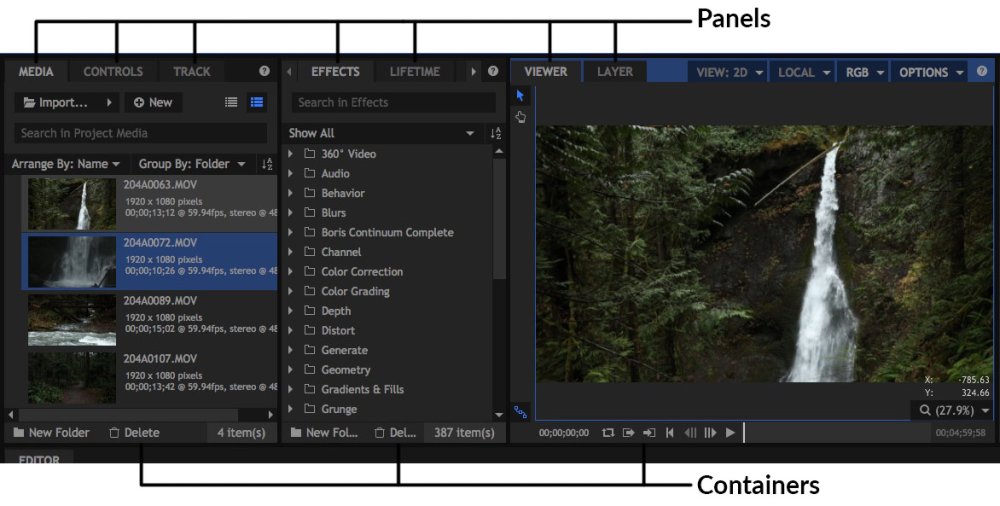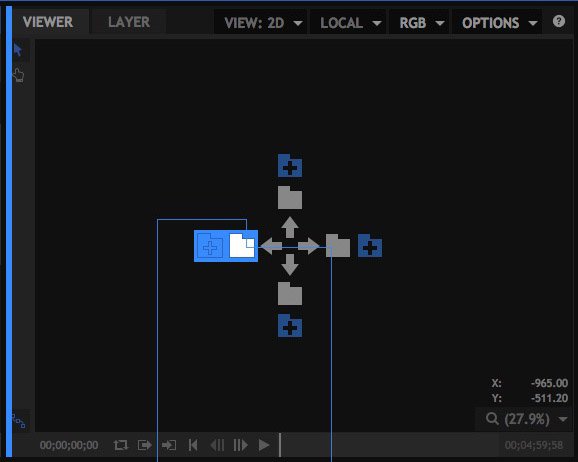HitFilm’s interface can be fully customized. The Workspace menu displays controls for turning individual panels on and off, switching workspace and managing your custom workspaces.
The workspace menu can be opened using the icon at the top of the screen:
HitFilm Pro offers a variety of standard workspaces, to suit many common tasks.
- 360 Video Editing: Optimized for working with 360 degree video.
- All Panels: A feature-rich workspace with all panels enabled. Easy access to all editing and compositing features.
- Audio: Focuses on the Audio mixer and other tools for editing and fine tuning your audio tracks.
- Classic: Based on the default layout in HitFilm 2 Ultimate. This retro option might be more familiar to users coming from a very early version of the software.
- Colorist: Scopes and large viewports facilitate accuracy and ease of use while you work on dialing in perfect colors.
- Compositing: Optimized for compositing, with emphasis on the controls and effects panels.
- Editing: Optimized for editing, with emphasis on the trimmer, media panel and viewer. This workspace is ideal for reviewing the contents of each clip in your Media panel, selecting the portions you want to use, and adding them to the timeline.
- Organize: Makes it easier to organize complex projects, when you have numerous imported files to go through, select, and rename.
Designing Your Own Workspaces
Workspaces can be fully customized, and you can create your own workspace templates. Details on how to customize the layout of the panels and containers that mke up the HitFilm interface is detailed below.
When you have a layout that you wish to save for later use, open the workspace menu and select Create. Anew window will appear, where you can name your new workspace. After you click OK, your new workspace will be available through the Workspaces menu.
If you are on a Mac, then after creating your workspace layout you will open the View menu and select Save Workspace. Enter the name you wish to use, and after clicking OK, the workspace will be available in the View > Workspaces menu.
Containers and Panels
The HitFilm interface is designed using a mixture of Containers and Panels. A container can hold multiple panels. Each panel will have a tab, and you can click the tabs to switch between panels.

The size of containers can be adjusted by dragging on the container’s edges.
Panels can be moved between containers by clicking and dragging on the panel’s tab.
Containers can be moved around the screen by clicking and dragging on an empty area of the container’s title bar.
Dragging a container over another container will display a 4-way drop zone indicator.

As you drag the container onto any zone, a blue line appears along the corresponding edge of the container, indicating where the container will be placed when you drop it. Dropping the container onto the relevant zone will insert the container to the left/right/top/bottom of the affected container, where the blue line was.
Floating Containers
Containers can also be separated from the main window and moved into their own ‘floating’ windows. These can then be dragged anywhere around your desktop. This can be useful if you want to move the viewer onto a second monitor, for example.
To float a container, simply right click its title bar and select Float Container.
To move a floating container back into the main interface click the workspace icon in the floating container’s title bar.
You can also drag a floating panel back into the interface, by choosing a new container location and dragging the tab of the floating panel into the header of that container.
